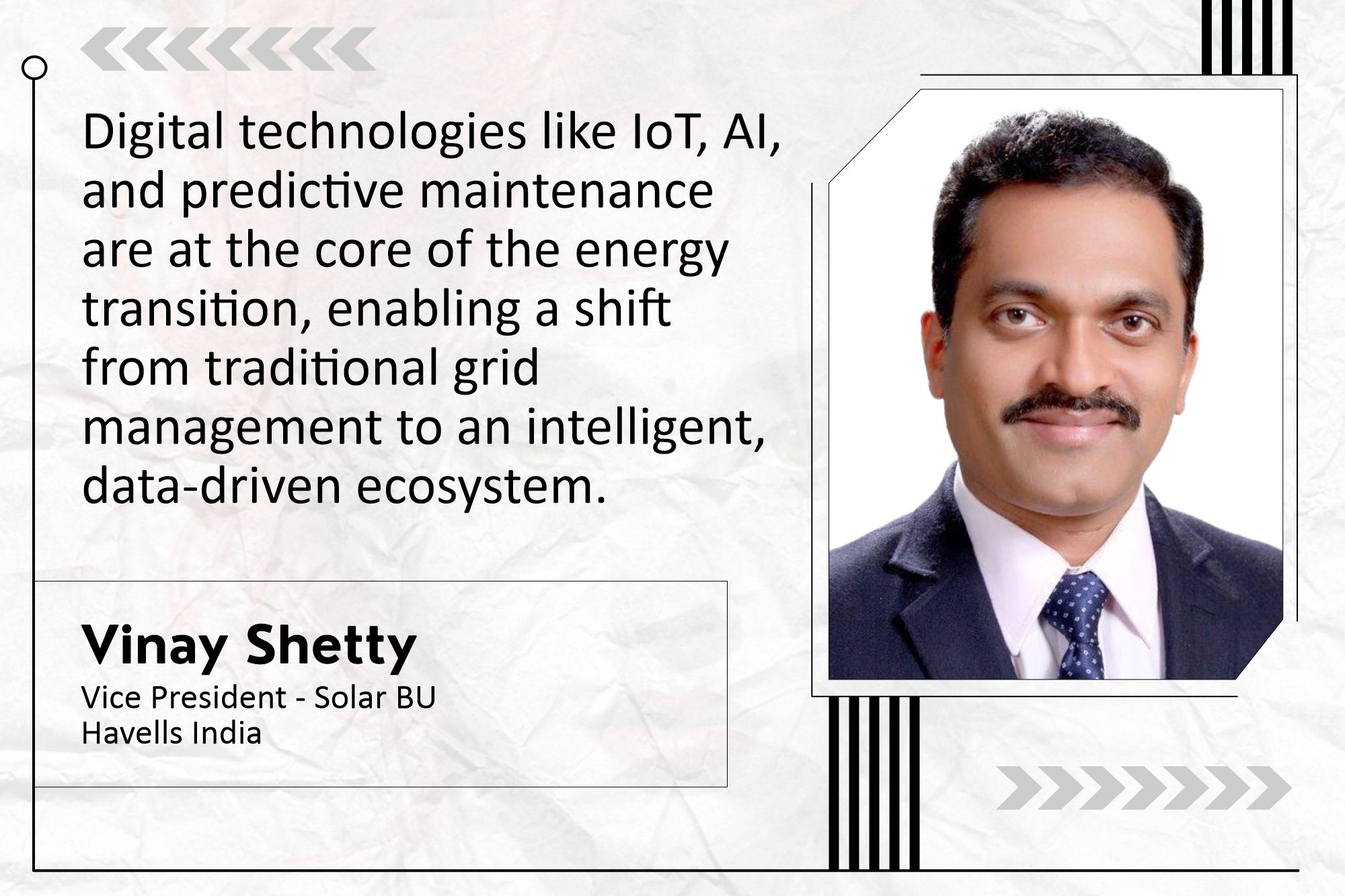Havells is future-ready with solar on-grid, off-grid solutions
By EPR Magazine Editorial March 26, 2025 3:25 pm IST
By EPR Magazine Editorial March 26, 2025 3:25 pm IST

India is experiencing an energy transition, which demands advanced electrical solutions for grid stability and efficiency. With digital technologies, smart inverters, and energy storage systems, Havells is leading the way in developing future-ready infrastructure. Vinay Shetty shares more in talks with EPR; let us hear him.
How can advanced electrical solutions and AI-driven energy management systems enhance grid stability?
As India and the world at large rapidly transition towards renewable energy, the need for advanced, intelligent, and efficient electrical solutions is greater than ever. Considering the erratic nature of renewable energy resources and owing to industries embracing electrification and energy efficiency, smart inverters, high-voltage transformers, smart meters, and AI-driven energy management systems are essential to ensure grid stability and seamless energy distribution. The transition to renewable energy and the use of advanced electrical equipment can lead to lower energy costs, reduced carbon emissions, and improved energy security.
With an extensive product portfolio of solar on-grid inverters and off-grid solutions, Havells is at the forefront of developing future-ready electrical infrastructure, ensuring India’s energy ecosystem is sustainable, resilient, and future-ready.
How can digital technologies and predictive maintenance enhance grid resilience and efficiency?
The push for grid modernisation and renewable energy expansion demands a smarter, more resilient, efficient electrical infrastructure. Digital technologies like IoT, AI, and predictive maintenance are at the core of this transformation, enabling a shift from traditional grid management to an intelligent, data-driven ecosystem. From dodging unpredictable equipment failure to extended lifespan, a robust automated ecosystem will be crucial to optimising the performance of electrical systems.
As an industry leader, we recognise this potential as we actively integrate analytics and robotics into manufacturing; Artificial Intelligence (AI) and IoT are embedded across our portfolio, optimising efficiency and energy management. Our Havells Sync app provides detailed energy insights, fostering grid-friendly consumer behaviour. By integrating digital intelligence into our products and infrastructure solutions, we aim to support India’s transition to a future-ready, technology-driven, sustainable, resilient, and globally competitive power sector.
How is the PLI scheme boosting local manufacturing and supporting Havells’ innovation and sustainability efforts?
The Production-Linked Incentive (PLI) scheme is crucial in strengthening the country’s local manufacturing ecosystem, particularly in the electrical equipment sector. By providing financial incentives for domestic production, the scheme encourages investments in advanced manufacturing capabilities, fosters innovation, and enhances global competitiveness. At Havells, we are at the forefront of leveraging this opportunity by actively investing in state-of-the-art manufacturing facilities, automation, and R&D to develop high-quality electrical components within India. Currently, 80 percent of our products are sourced domestically, aligning with ‘Make in India’ and PLI-driven initiatives, thus, staying true to our commitment to innovation and sustainability.How can strengthening local supply chain and workforce upskilling address challenges in achieving 500 GW non-fossil energy target?
The target of integrating 500 GW of non-fossil fuel energy by 2030 presents immense opportunities. However, the electrical equipment sector faces significant challenges, including grid modernisation and stability and the scarcity of accredited testing facilities for electrical equipment. Another key challenge the sector faces is its high import dependence on components like power electronics, transformers, and battery storage systems.
As we advance, strengthening the local supply chain, enhancing R&D capabilities while upskilling the workforce, and fostering innovation will support this transformation. These efforts, enabled by a strong policy framework and support, will give India a boost in its ambition of being a powerhouse of renewable energy.
How can the energy storage sector, with co-located storage and technological advancements, support grid stability and RE goals?
The energy storage sector is rapidly evolving to support efficient energy management and grid stability, driven by the increasing deployment of grid-scale battery systems and renewable energy integration. As power demand surges, energy storage systems (ESS) are essential for balancing supply and demand. The Indian government mandates that solar tenders include co-located storage systems, aiming for 14 GW/28 GWh capacity by 2030 to address renewable intermittency.
The government has mandated co-located storage for solar projects to enable this transformation, targeting 14 GW/28 GWh of capacity by 2030. Policies like the National Energy Storage Mission and production-linked incentives further accelerate domestic battery manufacturing. States such as Andhra Pradesh and Gujarat are at the forefront of deploying large-scale battery storage solutions to strengthen grid resilience.
We use cookies to personalize your experience. By continuing to visit this website you agree to our Terms & Conditions, Privacy Policy and Cookie Policy.